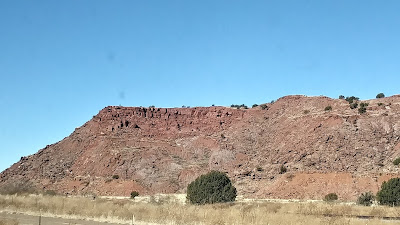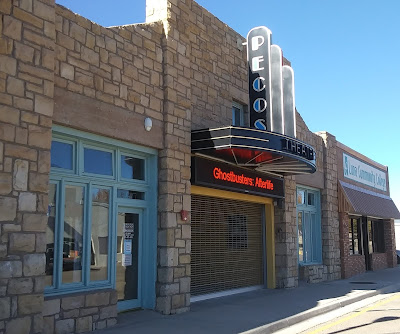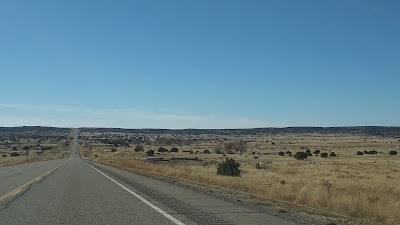It was Sunday morning in Tucumcari, New Mexico, when that old song started playing in my head. I think it was Sunday morning, anyway. The days tend to jumble together at times on the road.
We don’t try to make a lot of miles on our first two days, because on Day 1 and Day 2 we have family destinations, and once we reach those towns, we go no farther. Arriving in midafternoon daylight, we settle into our temporary digs at leisure and meet family in the evenings.
Day 3, however, is different. And as the Artist wanted to cross the Mississippi at St. Louis (ugh!) rather than Hannibal this time, so that we could grab an expressway (ugh!) angling southwest, it was not my favorite day of the trip. All I can say is that if you mustcross at St. Louis, where the tangled knot of criss-crossing high-speed roads makes going around Chicago look like child’s play, doing so early on a weekend morning (Saturday, in our case) is probably as good as it can get, and it would also be much more difficult if the driver were alone and had no navigator. The rolling pastures of Missouri are beautiful, but my eye was drawn continually to the old road paralleling the expressway. On expressway, I always feel as if I’m on a conveyor belt: there is no slowing down or stopping to, for instance, photograph an interesting sight. Of course, that is the whole point of expressways. Keep rolling nonstop!
Here is a further thought I had about expressways. They are, in the best designs, thoroughly rational. Logical and rational from an engineering point of view, that is, which is another part of the problem (for me), related to but distinct from their nonstop nature. Threading the convoluted knot of St. Louis, for instance, one loses any sense of direction. Where is east, and where is west? North, south? These interchanges did not grow organically from earlier roads that took the place of footpaths that developed along animal trails, and the gap between the organic and the rational is enormous, a difference of kind rather than degree. They are really two different worlds, one we follow with our body’s animal senses, the other a system our minds must bend and twist to follow, ignoring those same animal senses.
I am a book person. Life in the slow lane is my preferred mode. The trail from Michigan to Arizona is a long one, however, and we were not traveling as tourists. In Illinois there was no time to visit the shrine (as I think of it) to the memory of Mother Jones or to explore the Cahokia Mounds, and speeding through Missouri the whole point was to reach Tulsa by nightfall. As I say, it was the most difficult day on the road for me.
 |
| Our view of Tulsa |
Day 4 arrived. We departed Tulsa. By the time we reached western Oklahoma, the land began to open out to wide, long horizons, and my heart began to lighten and lift and expand. Forget about right and left brains. For me it is my heart that has at least two different homelands, Michigan Great Lakes and Western rangeland and mountains. There in western Oklahoma and on into and across the Texas panhandle, we were on the high plains. I always think of a friend who lived for years in South America and shared with me her romantic notion of the altiplano. Shoulders straighten, eyes search the horizon, lungs expand and take in great gulps of air.
Despite the Artist’s dedication to expressway speed, he was happy to detour off the road so we could revisit Vega, Texas. Years before we had had a pleasant lunch at the little bakery café across from the courthouse square, where the rancher husband was filling in for his baker wife, who was off on a catering job elsewhere. Then the stop got lost in memory’s shuffle, and search the map as we might, we could never remember the name of the town or find it again on our travels. But that was because we had developed a different route, one that took us through Kansas and down through only the smallest slivers of the panhandles of Oklahoma and Texas. But this time, on the road first taken, we found Vega again. It was Sunday evening, so not surprising that the café was not open, but it was satisfying to see the little town again and remember our earlier encounter and a walk with Sarah after that lunch. Memories don’t have to be spectacular and full of fireworks to be important.
Night found us in Tucumcari, New Mexico, with the moon rising huge and burnt orange as we ventured out for a bite of supper.
Day 5. The burnt orange moon of the night before was pale white in the morning. “It’s a long, long trail a winding,” sang my heart. We were not yet in Arizona, but my heart felt it had reached its Southwestern home, and the Artist too was relaxed now and felt we could afford time to look around a little before pushing on. I asked only that we find the train station, since my only photograph of it the year before had not satisfied me at all. I also spotted an intriguing building that the Artist turned back cheerfully for me to photograph, agreeing that it was worth taking time to see. Those scenes are here.
Mesalands! Need I say more?
Then breakfast in Santa Rosa – dear little Santa Rosa! I am always happy in that little town. There are still many sad relics from the vanished glory of Route 66, but I was thrilled to see the movie theatre on the courthouse square showing films and looking all spruced up and lovely. The grocery store, too, seemed to boast a new and cleaner look. “You see? It’s coming back!” The Artist finds me “something else” in my love for Santa Rosa.
And by the way, should you happen on an onsite notice that the Santa Fe Grill in Santa Rosa is “permanently closed,” please note that it is NOT. The owner died, and the restaurant was closed for a time, but heirs have now re-opened for business. Good news for travelers and locals alike!
And oh, from Santa Rosa – no more expressway but the old, long road (one white-knuckled experience was enough to teach us to fill the gas tank before taking the road south) through beautiful open country dotted with dark green one-seed juniper and dusty cholla. Through Vaughn and Corona and Duran. On our last pass through Duran, we explored one side of the highway, promising ourselves to explore the other the next time. And it turns out there is much more to Duran than we had realized. We explored all the way back to the three cemeteries (two ranch families each have cemeteries of their own), and I searched on my phone for some of the history of Duran -- very interesting!
Tularosa, Alamagordo, through the mountain pass, and on through Las Cruces and Mesilla. Had we not lingered to poke around in Tucumcari and Santa Rosa and Duran, we might have completed the trip on Day 5, but the slower pace was rewarding, our fifth day a happy day of relaxed driving, and it felt fine to stop for the night in Deming, knowing we would arrive in Dos Cabezas with plenty of daylight for our settling in.













2 comments:
Your story of this trip is wonderfully revealing - what lifts you, and what does not. Your photos are just exquisite, each one seeming to burst forth into a short story someone has told or one which needs to be told. The bakery-cafe and the white gas station, then the stone-fronted Pecos movie house have a western story to tell us, I feel.
Funny, a few of those towns you mentioned are ones that Tom and I had bumped into when he was in boot camp in El Paso. A few lifetimes ago, but I remember the mesas and the wide opened views, oh and the sunsets! A relaxing, reflective vista as I remember, and as your photos show so well.
Enjoy settling in! Ah….
Oh, Jeanie, there are SO many more sights I had no time to capture with my phone. Yes, my phone. I knew I had packed my camera, but it did not emerge until we arrived here in Dos Cabezas. Anyway, I'm glad you could enjoy the trip with me. Ah, yes, the mesas, the vistas, the sunsets! And now, a little after 8 a.m., the clouds are parting here in the ghost town, and the sun bursts forth. We are here at last.
Post a Comment